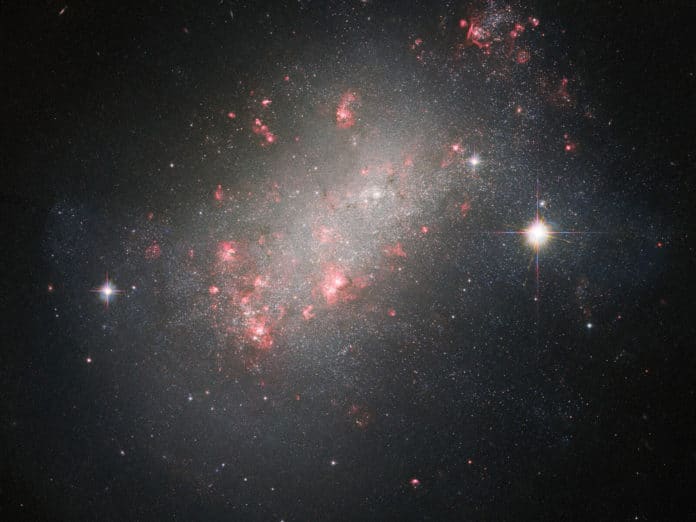In this Hubble Picture of the Week, the galaxy featured is NGC 1156. The galaxy has a shape unlike many of the galaxies familiar to Hubble. Located about 25 million light-years from Earth, in the constellation Aries, the NGC 1156 resembles a delicate cherry blossom tree flowering in springtime.
Hubble has captured NGC 1156 before. But, this new image features data from a galactic gap-filling program titled “Every Known Nearby Galaxy.” Its thousands of bright stars evoke a spiral galaxy, but it lacks the characteristic ‘winding’ structure.
The gleaming red blooms twisted by dust clouds stand out as well; these are the sites of active star formation. But it also emits a diffuse glow that resembles the central region of an elliptical galaxy, which contains older, redder stars. Astronomers refer to this miracle of the universe as NGC 1156.
NGC 1156 has some exciting features. Besides being a dwarf irregular galaxy, NGC 1156 is also classified as isolated, meaning no other galaxies are nearby enough to influence its odd shape and continuing star formation. While the galaxy’s center is tightly packed with older generations of stars, the tremendous intensity of recently generated new stars gives it color against the red glare of ionized hydrogen gas.
The shining red blossoms also stand out, twisted by dust clouds — these are the locations of intense star formation. It also radiates a diffuse glow, much like an elliptical galaxy and its core of older, redder stars.
NASA’s officials explained, “We noticed that only three-quarters of the galaxies within just over 30 million light-years of Earth had been observed by Hubble in sufficient detail to study the makeup of the stars within them. We proposed that in between larger projects, Hubble could take snapshots of the remaining quarter — including NGC 1156. Gap-filling programs like this ensure that the best use is made of Hubble’s valuable observing time.”
A close encounter with another galaxy may have occurred in the past for NGC 1156 because some pockets of gas within the NGC 1156 rotate counterclockwise to the rest of the galaxy. The gravity of this other galaxy — and the turbulent chaos of such an interaction — could have scrambled the likely more orderly rotation of material within NGC 1156, producing the odd behavior observed today.
